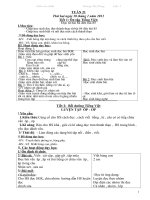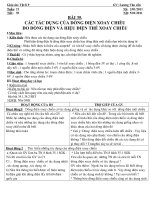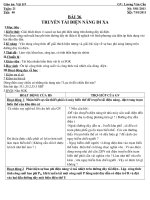Bài soạn Chapter 21 Biochemistry
Bạn đang xem bản rút gọn của tài liệu. Xem và tải ngay bản đầy đủ của tài liệu tại đây (5.75 MB, 85 trang )
Chapter 21
Biochemistry
2011, NKMB Co., Ltd.
Chemistry, Julia Burdge, 2
st
Ed.
McGraw Hill.
Mr. Truong Minh Chien ;
/>
2
Lipids
•
chemicals of the cell that are insoluble in water, but
soluble in nonpolar solvents
•
fatty acids, fats, oils, phospholipids, glycolipids,
some vitamins, steroids, and waxes
•
structural components of cell membrane
because they don’t dissolve in water
•
long-term energy storage
•
insulation
Chemistry, Julia Burdge, 2
nd
e., McGraw Hill.
3
Fatty Acids
•
carboxylic acid (head) with a very long
hydrocarbon side-chain (tail)
•
saturated fatty acids contain no C=C double bonds
in the hydrocarbon side-chain
•
unsaturated fatty acids have C=C double bonds
monounsaturated have 1 C=C
polyunsaturated have more than 1 C=C
CH
3
CH
2
CH
2
CH
2
CH
2
CH
2
CH
2
CH
2
CH
2
CH
2
CH
2
CH
2
CH
2
C
O
OH
Head
Tail
Chemistry, Julia Burdge, 2
nd
e., McGraw Hill.
4
Fatty Acids
Stearic Acid – C
18
H
36
O
2
a saturated fatty acid
CH
2
CH
2
CH
2
CH
2
CH
2
CH
2
CH
2
CH
2
CH
2
CH
2
CH
2
C
O
OHCH
2
CH
2
CH
2
CH
2
CH
2
CH
3
Oleic Acid – C
18
H
36
O
2
a monounsaturated fatty acid
CH
2
CH
2
CH
CH
CH
2
CH
2
CH
2
CH
2
CH
2
CH
2
CH
2
C
O
OHCH
2
CH
2
CH
2
CH
2
CH
2
CH
3
Chemistry, Julia Burdge, 2
nd
e., McGraw Hill.
5
Fatty Acids
Chemistry, Julia Burdge, 2
nd
e., McGraw Hill.
6
Structure and Melting Point
Name
MP
°C
Class
Myristic Acid 58 Sat., 14 C
Palmitic Acid 63 Sat, 16 C
Stearic Acid 71 Sat, 18 C
Oleic Acid 16 1 DB, 18 C
Linoleic Acid -5 2 DB, 18 C
Linolenic Acid -11 3 DB, 18 C
•
Larger fatty acid = Higher
melting point
•
Double bonds decrease the
melting point
More DB = lower MP
•
Saturated = no DB
•
Monounsaturated = 1 DB
•
Polyunsaturated = many DB
Chemistry, Julia Burdge, 2
nd
e., McGraw Hill.
7
Effect on Melting Point
•
since fatty acids are largely nonpolar, the main
attractive forces are dispersion forces
•
larger size = more electrons = larger dipole =
stronger attractions = higher melting point
•
more straight = more surface contact = stronger
attractions = higher melting point
Chemistry, Julia Burdge, 2
nd
e., McGraw Hill.
8
cis Fats and trans Fats
•
naturally unsaturated fatty acids contain cis
double bonds
•
processed fats come from polyunsaturated fats
that have been partially hydrogenated –
resulting in trans double bonds
•
trans fats seem to increase the risk of coronary
disease
Chemistry, Julia Burdge, 2
nd
e., McGraw Hill.
9
Fats and Oils: Triglycerides
•
fats are solid at room temperature, oils are liquids
•
triglycerides are triesters of glycerol with fatty acids
the bonds that join glycerol to the fatty acids are called
ester linkages
Glycerol
CH
2
CH
2
CH
2
OH
OH
OH
CH
2
CH
2
CH
2
O
O
O
C
C
C
O
O
O
CH
2
CH
2
CH
2
CH
2
CH
2
CH
2
CH
2
CH
2
CH
2
CH
2
CH
2
CH
2
CH
2
CH
2
CH
2
CH
2
CH
2
CH
2
CH
2
CH
2
CH
2
CH
2
CH
2
CH
2
CH
2
CH
2
CH
2
CH
2
CH
2
CH
2
CH
2
CH
2
CH
2
CH
2
CH
2
CH
2
CH
3
CH
3
CH
3
ester linkage
Chemistry, Julia Burdge, 2
nd
e., McGraw Hill.
10
Tristearin
Chemistry, Julia Burdge, 2
nd
e., McGraw Hill.
Tro, Chemistry: A Molecular Approach 11
Triglycerides
•
triglycerides differ in the length of the fatty acid side-
chains and degree of unsaturation
side chains range from 12 to 20 C
most natural triglycerides have different fatty acid chains in
the triglyceride, simple triglycerides have 3 identical chains
•
saturated fat = all saturated fatty acid chains
warm-blooded animal fat
solids
•
unsaturated fats = some unsaturated fatty acid chains
cold-blooded animal fat or vegetable oils
liquids
Tro, Chemistry: A Molecular Approach 12
Tristearin
a simple triglyceride found in lard
Tro, Chemistry: A Molecular Approach 13
Triolein
a simple triglyceride found in olive oil
Tro, Chemistry: A Molecular Approach 14
Phospholipids
•
Esters of glycerol
•
Glycerol attached to 2 fatty acids and 1 phosphate group
•
Phospholipids have a hydrophilic head due to phosphate
group, and a hydrophobic tail from the fatty acid
hydrocarbon chain
•
part of lipid bilayer found in animal cell membranes
Tro, Chemistry: A Molecular Approach 15
Phosphatidyl Choline
Tro, Chemistry: A Molecular Approach 16
Lipid Bilayer
Tro, Chemistry: A Molecular Approach 17
Glycolipids
•
similar structure and properties to the
phospholipids
•
the nonpolar part composed of a fatty acid chain
and a hydrocarbon chain
•
the polar part is a sugar molecule
e.g., glucose
Tro, Chemistry: A Molecular Approach 18
Glucosylcerebroside
(found in plasma membranes of nonneural cells)
CH
CH
C
H
CH
CH
O
OH
OH
OH
O
CH
2
OH
CH
CH
CH
2
OH C
H
C
H
N
C
O
Tro, Chemistry: A Molecular Approach 19
Steroids
•
characterized by 4 linked carbon
rings
•
mostly hydrocarbon-like
dissolve in animal fat
•
mostly have hormonal effects
•
serum cholesterol levels linked to
heart disease and stroke
levels depend on diet, exercise,
emotional stress, genetics, etc.
•
cholesterol synthesized in the liver
from saturated fats
Tro, Chemistry: A Molecular Approach 20
Steroids
cholesterol
HO
CH
3
CH
3
CH
3
CH
3
CH
3
O
CH
3
CH
3
OH
testosterone
HO
CH
3
OH
estrogen
β-estradiol
Tro, Chemistry: A Molecular Approach 21
Carbohydrates
•
carbon, hydrogen, and oxygen
•
ratio of H:O = 2:1
same as in water
•
contain carbonyl groups and alcohol groups
•
the many polar groups make simple carbohydrates
soluble in water
blood transport
•
also known as sugars, starches, cellulose, dextrins, and
gums
Tro, Chemistry: A Molecular Approach 22
Classification of Carbohydrates
•
hydroxycarbonyls - have many OH and one C=O
aldose when C=O is aldehyde, ketose when C=O is ketone
•
names of mono and disaccharides all end in ose
•
monosaccharides - cannot be broken down into simpler
carbohydrates
triose, tetrose, pentose, hexose
•
disaccharides - two monosaccharides linked
lose H from one and OH from other
•
polysaccharides - 3 or more monosaccharides linked
into complex chains
starch and cellulose polysaccharides of glucose
Carbohydrate Formula Source
Glucose (mono) C
6
H
12
O
6
blood, plants, fruit, honey
Fructose (mono) C
6
H
12
O
6
plants, fruit, honey
Galactose (mono) C
6
H
12
O
6
Sucrose (disac) C
12
H
22
O
11
sugar cane & beets, maple syrup,
fruits & veggies
Maltose (disac) C
12
H
22
O
11
partial hydrolysis of starch
Lactose (disac) C
12
H
22
O
11
milk (5%)
Starch (poly) potatoes, corn, grains
Cellulose (poly) cell wall of plants
Saccharides
Tro, Chemistry: A Molecular Approach 24
Optical Activity
•
there are always
several chiral carbons
in a carbohydrate –
resulting in many
possible optical
isomers
Tro, Chemistry: A Molecular Approach 25
HOH
2
C
C
C
H
O
OHH
C
C
H
O
OHH
HOH
2
C
OH
H
C
C
C
CH
2
OH
H
H
O
OH
OH
H
C
C
C
CH
2
OH
OH
H
O
OH
H
H
C
C
H
O
OHH
HOH
2
C
H
OH
HOH
2
C
C
C
H
O
HOH
D-(d)-Glyceraldehyde
D-(l)-Erythrose D-(l)-Threose
L-(l)-Glyceraldehyde









